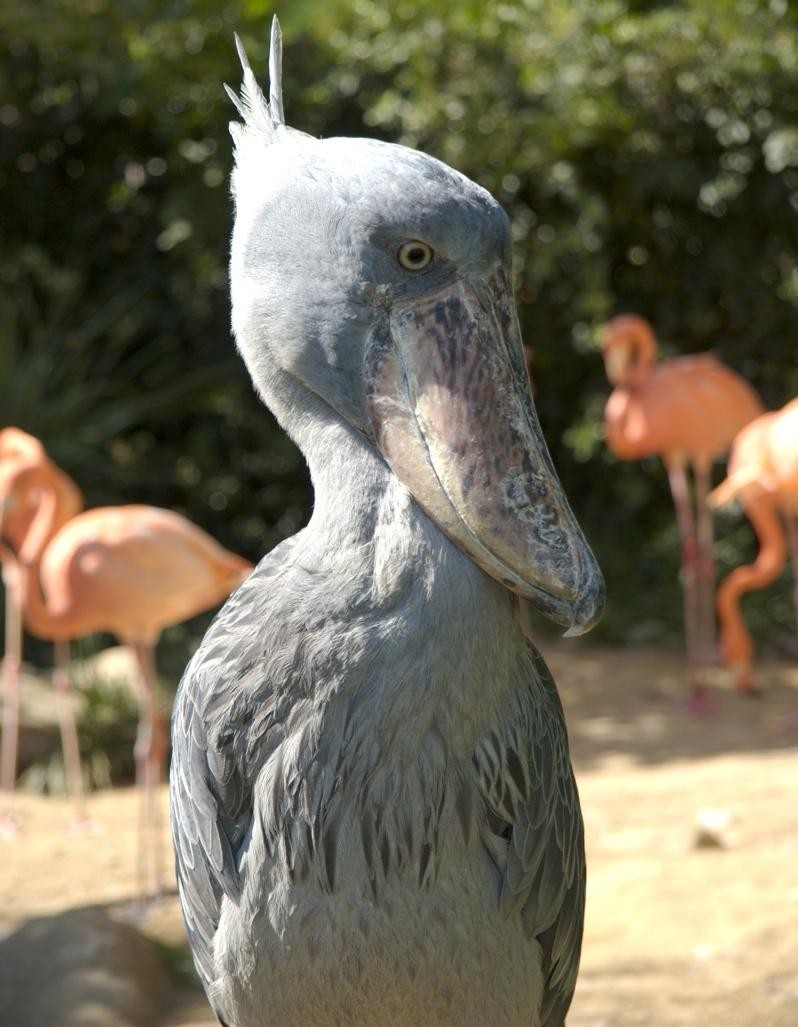- Shoebill
Taxobox
name = Shoebill
status = VU | status_system = IUCN3.1
status_ref = [IUCN2006|assessors=BirdLife International |year=2006|id=2473|title=Balaeniceps rex|downloaded=11 May 2006 Database entry includes a range map and justification for why this species is vulnerable]
trend = down

image_width = 250px
regnum =Animal ia
phylum = Chordata
classis = Aves
ordo =Ciconiiformes orPelecaniformes
familia = Balaenicipitidae
familia_authority = Bonaparte, 1853
genus = "Balaeniceps "
genus_authority = Gould, 1850
species = "B. rex"
binomial = "Balaeniceps rex"
binomial_authority = Gould, 1850The Shoebill, "Balaeniceps rex", also known as Whalehead, is a very large
bird related to thestork s. It derives its name from its massive shoe-shaped bill.The Shoebill is a very large bird. The adult is 115-150 cm (45-59 in) tall, 100-140 cm (40-55 in) long, 230-260 cm (91-103 in) across the wings and weighs 4 to 7 kg (8.8-15.5 lbs). [http://www.biolib.cz/en/taxon/id21133/?elang=CZ] [http://www.arkive.org/species/GES/birds/Balaeniceps_rex/more_info.html?section=factsAndStatus] The adult is mainly grey while the juveniles are browner. It lives in tropical east
Africa in large swamps fromSudan toZambia .[
Ueno Zoo inJapan .]This species was only discovered in the 19th century when some skins were brought to
Europe . It was not until years later that live specimens reached the scientific community. However, the bird was known to both ancientEgyptians andArabs . There are Egyptian images depicting the Shoebill, while the Arabs referred to the bird as "abu markub", which means "one with a shoe", a reference to the bird's distinctive bill.Shoebills feed in muddy waters, preying on
lungfish and similar fish. They nest on the ground and lay 2 eggs.The population is estimated at between 5,000 and 8,000 individuals, the majority of which live in Sudan.
BirdLife International have classified it as Vulnerable with the main threats being habitat destruction, disturbance and hunting.The Shoebill is one of the bird taxa whose taxonomic treatment is murky. Traditionally allied with the
stork s (Ciconiiformes ), it was retained there in theSibley-Ahlquist taxonomy which lumped a massive number of unrelated taxa into their "Ciconiiformes". More recently, the shoebill has been considered to be closer to thepelican s (based on anatomical comparisons; Mayr, 2003) or theheron s (based on biochemical evidence; Hagey "et al.", 2002). The fossil record does not shed much light on the issue, as usual when dealing with birds. So far, two fossil relatives of the shoebill have been described:Goliathia from the earlyOligocene ofEgypt andPaludavis from the EarlyMiocene of the same country. It has been suggested that the enigmatic African fossil birdEremopezus was a relative too, but the evidence for that is very spurious indeed. All that is known of "Eremopezus" is that it was a very large, probably flightless bird with a flexible foot, allowing it to handle either vegetation or prey.World's first Shoebill in captivity was born in July 2008 at Parc Paradisio in
Belgium .Fact|date=September 2008Gallery
References
Bibliography
* Hagey, J. R.; Schteingart, C. D.; Ton-Nu, H.-T. & Hofmann, A. F. (2002): A novel primary bile acid in the Shoebill stork and herons and its phylogenetic significance. "Journal of Lipid Research" 43(5): 685–690. [http://www.jlr.org/cgi/reprint/43/5/685.pdf PDF fulltext]
* Mayr, Gerald (2003): The phylogenetic affinities of the Shoebill ("Balaeniceps rex"). "Journal für Ornithologie" 144(2): 157-175. [English with German abstract] [http://www.blackwell-synergy.com/doi/abs/10.1046/j.1439-0361.2003.03002.x HTML abstract]External links
* [http://www.shoebill.org Shoebill.org]
* ARKive - [http://www.arkive.org/species/GES/birds/Balaeniceps_rex/ images and movies of the Shoebill "(Balaeniceps rex)"]
* [http://www.birdlife.org/datazone/species/index.html?action=SpcHTMDetails.asp&sid=3808&m=0 BirdLife Species Factsheet]
Wikimedia Foundation. 2010.

_A_Shoebill_at_)